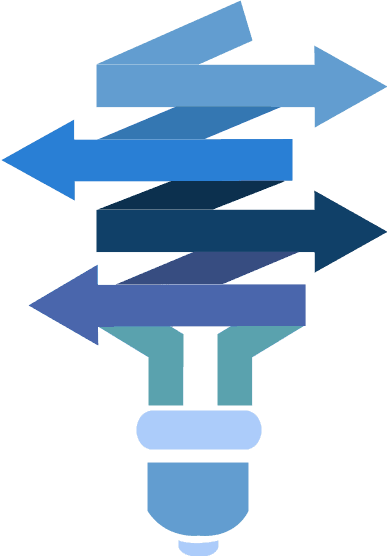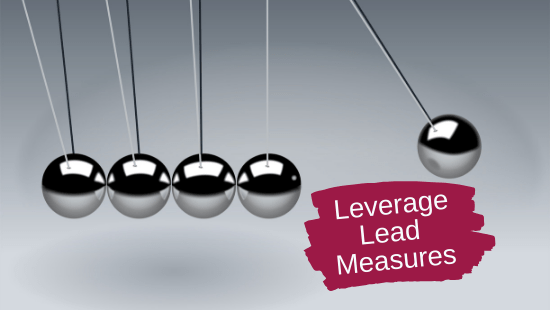Idea In Brief: We spend a lot of energy on metrics to drive performance, but we focus that effort on lag measurements instead of lead measurements. Lead measures allow you to shift the focus from the rear view perspective of “how did I do” to the current and actionable view of “how am I doing” that truly fuel execution.
(4 Minute Read)
Why do we measure? We certainly spend a lot of time doing it. We commit time, money and energy creating and maintaining measurement systems, so we must believe it’s essential. And we are good at it.
So if we are so good measuring ourselves why do fall short of executing our goals 54% of the time?
We fall short because we measure the wrong things.
Let’s consider an example. I could be spectacular at weighing myself every day on a $4,000 Health-O-Meter Body Composition Scale (yes, it’s a real thing), but will that ensure I achieve weight loss goals? No way.
Weight is not an actionable measurement. It’s a lag measurement.
Now contrast that to me setting daily goals for calorie consumption and physical activity and tracking those two measurements every day. I’ve got a much better shot at reaching my weight goals (lag measurements) if I track calories (lead measurement) and physical activity (lead measurement) regularly.
As lead measures, calorie consumption and physical activity are actionable measurements that predict weight.
Lead measurements drive results and therefore, should get our full focus and attention.
First, What Makes a Good Lead Measure?
Lead measures are those high-leverage actions you take to get the lag measures to move.
To be a good lead measure, as described in The 4 Disciplines of Execution: Achieving Your Wildly Important Goals, it should have these three characteristics:
Predictive: A lead measure should be predictive in that a change in the lead measure means a change in the lag measure (strategic goal).
Influenceable: The lead measure should be an action that is directly influenced by the team.
On-going Process: The measure should be something you repeatedly do and will benefit from the compounding effect (vs. a one-and-done improvement).
How Do We Identify Lead Measures?
Identifying lead measures isn’t that easy. It requires that we have a firm grasp on the essential drivers of our business/goal. If were are doing something we’ve never done before, we may not know what the real drivers are. So we must make some strategic bets.
Here’s one approach to help work through that process.
Step 1 - Goal
Identify the strategic goal and the corresponding lag measurement.
Step 2 - Activity
List the most significant activities that must be done regularly that are critical to achieving this goal.
Step 3 - Prioritize
After reviewing activities listed, assign a ranking based on impact on the goal.
Step 4 - Define
For the top 2-3 ranked activities, define how you will measure those critical activities, the frequency and the target goals you wish to achieve.
Note: If you have a complex strategic goal, I recommend breaking this step down into it down into the first milestone and identifying the lead measures based on that portion of the project.
You can download for free my Identifying Lead Measures Worksheet in the link below.
Identifying Lead Measures Worksheet
How Do You Use Lead Measures?
The point of the lead measures is to drive laser focus on the few activities that provide the most leverage needed to move you toward your target goals. It’s challenging, but we must resist the temptation to say we need to be doing all of these things! Remember this is about leverage.
It’s about finding the focus few and going all in to execute these activities because they will have the most significant impact.
Armed with these lead measures in hand, you and your team can turn your energy to the “how” part of executing these activities. Now that you know what you must do, how should you do it? The best part about this is the magic that ensues when you allow your team the creativity and autonomy to decide how to do the work.
Now that you are confident the team is focused on the right actions let them determine how to do their work.
To stay on track of performance goals, give lead measures the same visibility as their related lag measures by including them in your weekly, and monthly operating rhythms.

Idea into Action
Consider your organization’s most important, strategic goal. Ask these questions:
- What are two or three things that must happen (identify drivers) to achieve this goal?
- Based on these few drivers, what are the lead measurements you should track at least weekly?
- How can you incorporation this tracking into the current operating rhythm to provide the highest visibility?
Note: This process works great for those big, audacious personal goals too.
If you want to grow your sales, you’re not going to do it by measuring your sales. If you increase the number of times you measure sales from weekly to daily, do your sales go up? No, but if you increase the number of clients and prospective clients you meet with each week, you’ve got a much better shot at moving that sales number.
For me, the best part of implementing lead measurements is this: when the organization focuses on the drivers (lead measures) of performance, leaders can give teams the autonomy to find the best way to affect these drivers. People want to have control over their work. Just point them to the right measures, and then let them surprise you.
Please share your thoughts with me on this, and if you’ve found this information helpful, you can help me get the word out by using the links provided and sharing it with a colleague. Thanks!
Work well,


